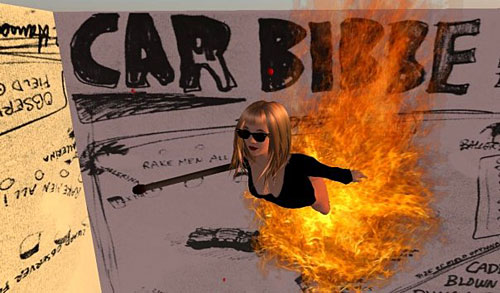
Still from the performance, Car Bibbe 2, based on a script by Al Hansen, and featuring the avatar of Bibbe Hansen. Second Front, 2008. © All rights reserved.
“Time” is always present in our interaction with works of art, whether we sit to contemplate a painting, stroll past a sculpture, or watch a video piece for its entire duration or cycle. Some works of art are time-based in that the viewer must experience them through the passage of time, as with music, while others refer to time through links or references to art history, our collective human history, or the timelessness of nature.
—Art:21—Art in the Twenty-First Century, Season 2, Episode: Time
Art in the twenty-first century, reflecting and defining new developments in a variety of areas, has radically extended the conventional media of time-based, or 4D work. Following Virtual Artists’ Immersive Discoveries in a Virtual 3D Frontier, I interviewed several Second Life artists who evoke time in their work.
Second Life artists are exploring how to captivate, or use the element of time to interact with an active audience. They have abandoned strict adherence to traditional hierarchies of art and embraced the virtual. In the past fifty years especially, ideas about time have shifted from passive to interactive and, currently, to perceptually immersive, via filmmaking and animation, the theatricality of performance, and virtual reality. This post highlights early visionaries in Second Life who are re-imagining how immersive 3D space can change, or transform 4D art.
Machinima (muh-sheen-eh-mah) is the convergence of filmmaking, animation and game development. It uses real-world filmmaking techniques that are applied within an interactive, immersive 3D space where characters and events can be either controlled by humans or scripts. In Second Life, the actors are avatars in the scene, and the computer (via screen capture software) doubles as the camera, recording everything that happens in the virtual world. It connotes the artistic and performative, or the collaborative action of artist and computer. [The Second Life elements from the Art:21 segment on Cao Fei were filmed using machinima methods. —Ed.]
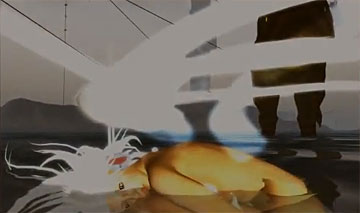
Still from My Friends Are Robots, ColeMarie Soleil, 2009. © All rights reserved.
“…the bird girl avatar weaves shimmery machinima with what seems like the internal monologue of the woman behind the computer, as she experiences Second Life, in other words, a stream of consciousness from within the metaverse.”
—Wagner James Au on ColeMarie Soleil
Art in Second Life is impermanent and as a result artists are finding new, creative ways to document, or memorialize the work. ColeMarie Soleil is one of several SL artists who have explored capturing the temporal aspects of immersive 3D art. I first encountered ColeMarie while interviewing Bryn Oh for my previous post. Bryn Oh’s work often serves as inspiration for ColeMarie’s machinima (she has composed songs for Bryn, as well).
Skye Galaxy performs Joga by Bjork, ColeMarie Soleil
ColeMarie Soleil: I have my artistic very serious videos where I hide a lot of personal meaning and stories inside of them. They are like waking dream sequences for me. I try to share what I love about SL and magic. Then, on the other hand, I have my serious documentaries where I capture sims (installations) and live performances from talented artists and musicians like Skye Galaxy, or AM Radio. I think the hard part of SL is that everything is transient. Nothing remains always.
My intent is to document the art I find that has hidden stories inside of them. These videos bring them to life for a watcher who might not understand Second Life. Long after the builds are gone the videos become like a trip back in time for friends and the artists who created them. It is a way to hold onto them as more than just memories or places we experienced. It’s something you can share after and have to tell stories with.
ColeMarie’s work has been exhibited at film festivals and other events in both real and virtual venues. Her My Friends Are Robots was awarded first place for Best Drama by The Machinima Artist Guild (M.A.G.), an association of Second Life users who produce Animation Films (Machinimas) in virtual worlds.
Fluxus, an international art movement identified with the 1960s, birthed innovations in filmmaking and performance. They introduced the concept of the viewer becoming the work of art through active participation. Performances were open-ended, experimental events or happenings that encouraged participants to record what had happened. Fluxus artists challenged audiences to think in new and unconventional ways. In Second Life performance art continues to break down conventional ideas about what art is.
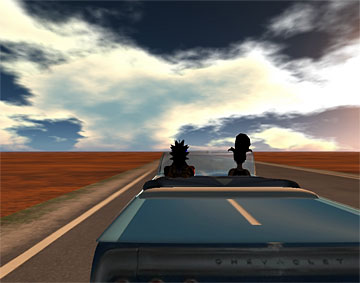
On the Road, Patrick Lichty, 2008. © All rights reserved.
Being a member of Second Front is a dream come true. It’s an unprecedented opportunity to collaborate and perform with an amazing group of wonderfully talented artists from all over the world. This would be an almost impossible undertaking for us in a pre-digital age. Festivals like the 1962 Fluxus Festival in Wiesbaden, the DIAS in London and YAM in New York City were rare once or twice in a lifetime events, while with the advent of three dimensional metaverse Second Life, we are able to meet and work regularly together as an on-going reality. The work of Second Front generally has double resonance as it weaves and interacts with the real life, “meatspace” art world.
—Bibbe Hansen AKA Bibbe Oh in SL
Performance artists have increasingly incorporated technological media into pieces—mainly because they have acquired exponential amounts of new technology. Second Life performance art includes poets, musicians, machinima makers, dancers, etc.—in addition to visual artists. Since 2006 Second Front has been one of the first performance art groups in SL. ZeroG Skydancers, founded by DanCoyote Antonelli (DC Spensley) has been doing live, in-world performances for a similar length of time. I was invited to join Man Michinaga (Patrick Lichty) at his retrospective on Odyssey, in Second Life. Man is a member of Second Front and collaborated with Art21 Season 5 featured artist Cao Fei for RMB City.
ZeroG SkyDancers: ZeroG VIII, Created, Produced, and Directed by DanCoyote Antonelli
Nettrice Gaskins: How would you describe your work to someone who has never experienced Second Life? How does your work demonstrate the range and importance of time and space? What differentiates your work from other 2D and 3D works? What is the relationship of the performer and participant?
Man Michinaga: I’m a virtual performance artist. I’m one of the founders of Second Front, a mainly RL-centered SL performance art group. The closest colleagues we have are Franco, Eva, and Gazira Babeli (Eva and Franco Mattes were the first guest bloggers on the Art21 Blog). Before this I was a founder/member of RTMark and The Yes Men. I’ve been investigating Dada and Fluxus, e.g. Happenings.
What we do are performances and interventions that play with the specificities of SL. For example last week we were asked to intervene and set performance artist Stelarc on fire. Second Life is a videogame-like performance that makes one wonder about what is left in performance once you remove the body, which seems utterly ridiculous but it isn’t because the affect remains. We really seem to feel through these puppets (avatars) of ours. The relational aspect of virtual worlds occurs through interaction with our audience or the creation of huge spectacles. The audience is free to do anything they wish. We invite participation.
The difference between our performances in RL and in SL is intent, a totally different intention and set of questions. The RL performances are usually interventionist/politic and critical. Here they are still critical but they are more about investigating sociology.
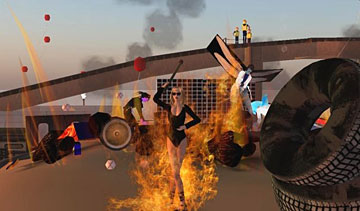
Still from the performance, Car Bibbe 2, based on a script by Al Hansen, and featuring the avatar of Bibbe Hansen. Second Front, 2008. © All rights reserved.
SL performance artists see immersion as a means of taking their art directly to a global audience, thus completely eliminating the need for physical exhibition spaces, although augmented reality exhibitions are becoming the norm. Fellow Second Front member Bibbe Oh (Bibbe Hansen) is the daughter of Fluxus member Al Hansen. Second Front bases their performance of Car Bibbe on a script by Al Hansen of Fluxus.
Bibbe Oh: At first, I had suggested to Patrick that Second Front redo the original Car Bibbe in SL. Later, going through some materials in my father’s archive, I came across Car Bibbe II, scanned it and sent it to Patrick who immediately made it happen. In the audience at the Bridge event were my dad’s original Fluxus-fellow travelers and partners in art crime—Geoffrey Hendricks with partner Sur Rodney Sur and Larry Miller. Both were quite impressed with the new media swing of things and thought we did Al Hansen proud with our rendition. A new generation of artists attended as well, partly represented by singer-songwriter, now emerging visual artist, Adam Green and friends. Though these were more familiar with digital performance as an everyday reality, they were yet enchanted to be able to experience the work of Al Hansen in this way.
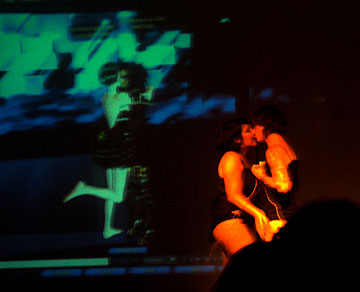
technésexual performed at the Hemispheric Institute for Performance and Politics 7th Encuentro at Mapa Teatro in Bogota, Colombia, 2009. echolalia Azalee and Azdel Slade. © All rights reserved.
Artists Azdel Slade (Micha Cardenas) and echolalia Azalee (Elle Mehrmand) set up a live video feed for my Mixed Reality interview with them. Mixed reality (MR) refers to the merging of real and virtual worlds to produce new environments where physical and digital objects co-exist and interact in real time. Mixed Reality events in SL are streamed real-time into a region. Streaming media is projected in the live event and may include feedback via text or audio from the Second Life audience.
Azdel Slade: This video is something we’re thinking about including in our performances in the future. We’ve been working on a series of mixed reality performances focusing on blurring the lines between physical reality and virtual reality, and most recently with technesexual, thinking about using sound to bridge the two realities. I’ve heard it described recently as an emerging paradigm but we want to try to get away from thinking in binary terms about RL/SL. That mirrors in a lot of ways our personal life experiences, since I’m a trans-woman. We don’t think of our relationship in binary terms.
technésexual performed at Artivistic TURN*ON, Montreal, 2009, echolalia Azalee and Azdel Slade
AS: SL also demonstrates this proliferation of new sexualities beyond what anyone would call lesbian/gay/bisexual/transgender. But what’s interesting to us, as you can see in our avatars, is mixing in new an interesting ways. With our performances we’re in a way demonstrating what we think of as a queer sexuality in RL and SL. We’re very interested in the tradition of performance art, finding and pushing on limits. SL is in a way a new space for performance art, thinking about how to perform in RL and SL at the same time.
echolalia Azalee: we invite audiences from both SL and RL.
AS: And we project SL so the live audience can see it. I think that we try to create an intimate relationship with the audience.
eA: So they are invited to experience this very intimate and personal moment.
AS: But also we try to invite them into a mixed reality environment where the image and sound from RL and SL are blurred, which is why we make our avatars projected life sized.
eA: Artist influences come from many genres such as Marina Abramovic and Ulay.
AS: I think our main influences come from performance and new media.
eA: And looking at their collaborations.
AS: Stelarc and Orlan who are pushing the limits of the body and technology. We’ve both worked with Ricardo Dominguez a lot and he’s inspired us to think about performance and how it changes in a technological context. He refers to the performative matrix, which I think is a useful idea; the way a performance operates in multiple spaces at the same time, social, cultural, political, sexual…
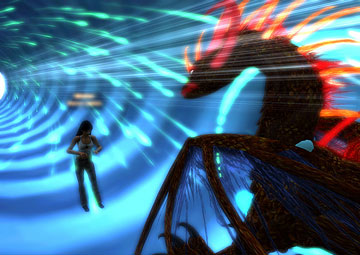
Still from Becoming Dragon, Azdel Slade, 2009. © All rights reserved.
As performing artists Azdel and echolalia are intent on infiltrating SL to exploit it for thinking of new forms of sexuality and identity. I was shown a scale model of Becoming Dragon. The installation included a “heteronormative” couch, red motion-capture cameras, and two large projection areas. This performance was a demonstration on how SL has a built-in structure of gender binaries. Currently they are working on documentation for technesexual, a performance that involves real bodies, SL avatars and merging the two using biometric sensors to monitor heart rate and temperature. They want to include and expand on the tradition of performance art of using the body as a medium.
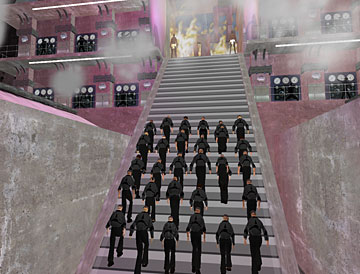
Still from the performance, Metropolis, inspired by Fritz Lang’s 1917 film. Cybernetic Art Research Projects (CARP), 2009. © All rights reserved.
Participation in virtual performance art removes barriers of entry and is judged by the reaction of the viewer. José den Burger and Velazquez Bonetto, founders of CARP (Cybernetic Art Research Projects), work in collaboration with artists, designers, engineers, and programmers in Second Life. Their performances allow audience members to “fly” inside the creations and become part of them.
José den Burger: Where in real life an artist creates mostly “alone”, in SL working with scriptwriters becomes common. Creators do not always have the knowledge of writing scripts as well and when you have made a beautiful (virtual) sculpture and it just stands there and “does” nothing is not very interesting. Scripted 3D objects rotate, change textures, fade or become transformed in ways that are powerful. Architects use the metaverse to build the most incredible buildings where you can walk in, look around and get the perception that you really are there. Scriptwriters and programmers can experiment and collaborate with others to develop new knowledge and technology to make things “happen”.
Pseudo-Futurist Video Game Improvisation Extravaganza (extract), Presented by PERFORMA09 (New York) and Odyssey (Second Life). Eva and Franco Mattes aka 0100101110101101.ORG, 2009.
Collectively, immersive 4D art in SL combines sensors, video, sound, streaming, web cams, projections, programming, the web platform, and other technologies to produce immersive, interactive and participatory performances and installations. Audiences are able to experience real and fictional places simultaneously. Other examples include Second Front’s homage to Andy Warhol, Ballet Pixelle, and mellifera, an on-line interactive environment in SL that is linked to a complimentary series of real-time exhibitions. Stelarc, an Australian performance artist, focuses heavily on extending the capabilities of the human body and is performing as his avatar in Second Life. For this post Franco Mattes aka 0100101110101101.ORG reflected on the nature of performance art as a collective hallucination taking place in real time, in perceptually immersive 3D space.
Franco Mattes: In our synthetic performances the performers and the audience only interact thorough avatars, they never meet. Everything is mediated. But this doesn’t mean the relationship is not “real”, as much as, for example, a “phone conversation” is a “real conversation”.
Ten years ago scholar Raoul Eshelman coined the term performatism to describe what we are now seeing take place in virtual 3D worlds such as Second Life. It’s an exciting time for new media in art!
Nettrice Gaskins is an artist and educator who bridges the actual and virtual worlds and explores how these realities can have a transformative impact on people’s lives and experiences when it can be fully implemented and realized. Her purpose is to bring together people, concepts, modalities, media, and worlds through art. Follow Nettrice’s blogs to explore writings on new media art and art in the classroom.




Pingback: My Latest PBS Art21 Guest Blog Post! « SL Art HUD Blog Thingie:
Pingback: transreal.org » Art21 Article features my and elle’s collaboration, technesexual
Pingback: Three great texts on Second Life art and the work « Patrick Lichty's Art, Research, and Polemics
Pingback: New Media in 4D Art « 4D Art and Design Fundamentals
Pingback: Participatory Culture & Social Capital in Virtual Art | Art21 Blog
Pingback: Beyond Boundaries: Art Exhibition & Virtual 3D Worlds | Art21 Blog
Pingback: Nictoglobe Online Magazine & Other News « SL Art HUD Blog Thingie:
Pingback: Field of Voices – Mobile AR Art & Performatism « SL Art HUD Blog Thingie:
Pingback: Film as Theater (Mise en scène) « Constructing the Moving Image
Pingback: Virtual Camera: Scene Analysis « Constructing the Moving Image
Pingback: Art21 2009 to the Present « SL Art HUD Blog Thingie:
Pingback: Art 2.1 | New Frontier at Sundance 2013: 4D Art and Augmented Real | Art21 Blog
Pingback: Picasso Baby: The New Society of the Spectacle | SL Art HUD Blog Thingie: